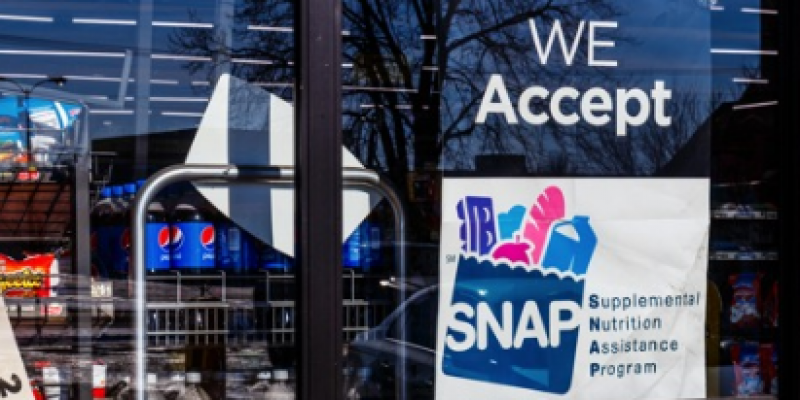The public comment period closed Monday on the U.S. Department of Agriculture’s (USDA) proposed rule to eliminate food stamp eligibility loopholes and standardize broad-based categorical eligibility (BBCE) guidelines.
The change is anticipated to cut 3.1 million recipients from the program, the USDA says, and save taxpayers $2.5 billion every year.
“For too long, this loophole has been used to effectively bypass important eligibility guidelines. Too often, states have misused this flexibility without restraint,” U.S. Secretary of Agriculture Sonny Perdue said in a prepared statement. “The American people expect their government to be fair, efficient, and to have integrity – just as they do in their own homes, businesses and communities. That is why we are changing the rules, preventing abuse of a critical safety net system, so those who need food assistance the most are the only ones who receive it.”
Currently, 43 states allow residents to automatically become eligible for food stamps through the Supplemental Nutrition Assistance Program (SNAP) if they receive benefits through Temporary Assistance for Needy Families (TANF).
A process in place for years, BBCE allows states to confer SNAP eligibility to households if they already are receiving TANF benefits, allowing states to work around SNAP’s asset limits stipulated for eligibility.
The rule change now requires TANF recipients to pass a review of their income and assets to determine whether they are eligible to receive SNAP benefits.
Widespread use of BBCE “has become so egregious that a millionaire living in Minnesota successfully enrolled in the program simply to highlight the waste of taxpayer money,” Perdue points out.
Congress has established clear eligibility standards, Perdue argues, saying it’s the USDA’s responsibility to ensure those who receive benefits are eligible.
To confer automatic eligibility for SNAP under the proposal, a household must receive TANF-funded cash or non-cash benefits valued at a minimum of $50 per month for at least 6 months, the rule states. In addition, non-cash benefits that could convey automatic eligibility would be restricted to subsidized employment, work supports, or childcare.
“By establishing clear standards and requiring that benefits be ongoing and substantial, the proposal will ensure SNAP benefits go toward Americans most in need,” the USDA says.
Seventeen Democratic governors wrote to Perdue urging him to rescind the rule “to preserve the flexibility needed to meet the food and nutrition needs of the low-income populations in our states.” Collectively, the governors from California, Colorado, Connecticut, Hawaii, Illinois, Maine, Montana, Michigan, Nevada, New Jersey, New Mexico, New York, North Carolina, Oregon, Pennsylvania, Washington and Wisconsin say they represent 149 million constituents.
Richard Besser, CEO and president of the Robert Wood Johnson Foundation (RWJF), told The Center Square he takes issue with the rule change.
“While fairness and efficiency are hallmarks of SNAP itself, the proposed rule represents the antithesis of those principles,” Besser said. “The proposed rule would undermine the ability of the program to do its job and make it harder for families to reduce financial hardship and become food secure. Millions of individuals, families, children, people with disabilities and the elderly would suffer as a result.”
An RWJF-funded analysis of the estimated impact of the proposed rule using an interactive data visualization from Mathematica found that more than 10 percent of SNAP households in 20 states would lose eligibility. Of the estimated more than 3.1 million people slated to lose SNAP benefits, 41 percent live in poverty, the analysis found, of whom 36 percent are children. Among the 3.1-plus million, only 45 percent report having income, including the elderly, who account for 32 percent and the disabled, who account for 10 percent.
Pointing to research conducted by The Urban Institute, Besser argues more than 2 million participants in households with children, more than 2 million people in working families, and more than 750,000 households with seniors and more than 300,000 households with people with disabilities would lose SNAP benefits.
However, the loophole has allowed more than 5 million people to enroll in the program who do not meet the eligibility criteria, the Foundation for Government Accountability (FGA) points out. In 2015 alone, nearly four million enrollees had countable assets above the federal threshold – meaning they never should have even received SNAP.
Asset limits, which are indexed to inflation, generally apply only to liquid assets, like cash or money deposited in bank accounts that are readily available, FGA notes.
“But while asset tests are common in other welfare programs, including cash welfare and even Medicaid for long-term care enrollees, states have used federal loopholes to virtually eliminate the requirement in food stamps and expand eligibility to millions of individuals who do not otherwise qualify,” Jonathan Ingram and Nicholas Horton, authors of a recent FGA report on BBCE, explain.
Most other types of assets are exempt, FGA notes, including home and property values, value of household and personal goods, life insurance, pension funds or retirement accounts, education savings accounts, and assets of enrollees receiving cash welfare or supplemental security income. All states also exclude at least one vehicle from the asset test, FGA adds, while 32 states exclude all vehicles.
“With the proposed rule, USDA is on track to correct a problem that has allowed individuals with significant assets – including millionaires – to collect food stamps. The rule would close the loophole that has allowed this, ensuring food stamp resources only go to those who actually qualify and are truly in need, and restoring the public’s faith in the program,” Sam Adolphsen, policy director at FGA, told The Center Square. “Without this rule in place, we’ll see continued abuse of the food stamp program that threatens resources for the truly needy.”
This article was first published by The Center Square.
Advertisement
Advertisement

